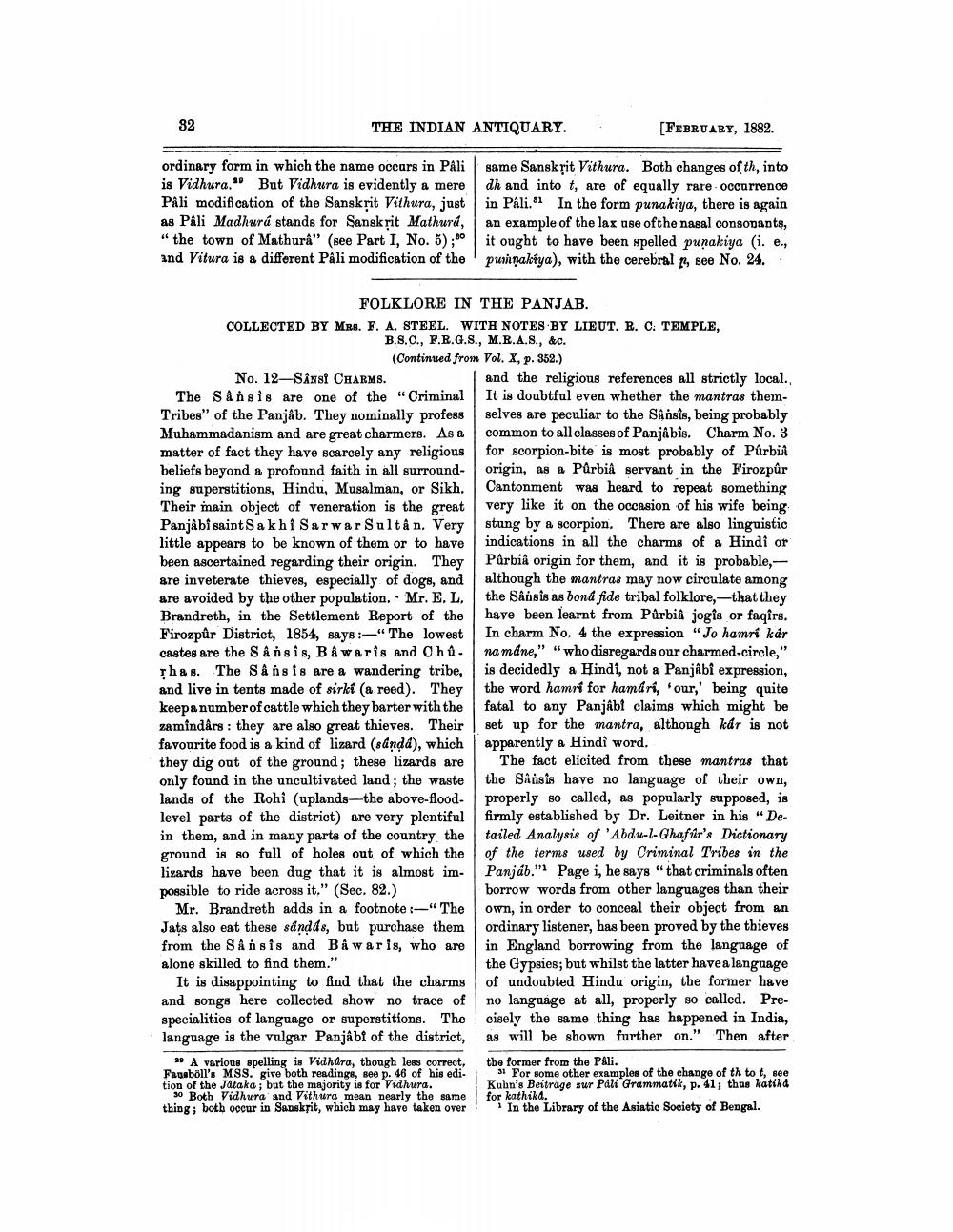________________
THE INDIAN ANTIQUARY.
.
[FEBRUARY, 1882.
ordinary form in which the name occars in Palisame Sanskrit Vithura. Both changes of th, into is Vidhura." But Vidhura is evidently a mere dh and into t, are of equally rare occurrence PAli modification of the Sanskrit Vithura, just in Pâli. In the form punakiya, there is again as Páli Madhurá stands for Sanskrit Mathurd, | an example of the lax use ofthe nasal consonants, " the town of Mathura" (see Part I, No. 5); 40 it ought to have been spelled punakiya (i. e., and Vitura is a different Páli modification of the purņakiya), with the cerebral , see No. 24..
FOLKLORE IN THE PANJAB. COLLECTED BY MRS. F. A. STEEL WITH NOTES BY LIEUT. R. C: TEMPLE,
B.S.C., F.R.G.S., M.B.A.S., &c.
(Continued from Vol. X, p. 352.) No. 12-SÂNSI CHARMS.
and the religious references all strictly local. The Sânsis are one of the “Criminal It is doubtful even whether the mantras themTribes" of the Panjab. They nominally profess selves are peculiar to the Sansis, being probably Muhammadanism and are great charmers. As a common to all classes of Panjabis. Charm No.3 matter of fact they have scarcely any religious for scorpion-bite is most probably of Purbia beliefs beyond a profound faith in all surround- origin, as a Purbiâ servant in the Firozpůr ing superstitions, Hindu, Musalman, or Sikh. Cantonment was heard to repeat something Their main object of veneration is the great very like it on the occasion of his wife being Panjabi saint Sakhi Sarwar Sultân. Very stung by a scorpion. There are also linguistic little appears to be known of them or to have indications in all the charms of a Hindi or been ascertained regarding their origin. They Pärbiâ origin for them, and it is probable, are inveterate thieves, especially of dogs, and although the mantras may now circulate among are avoided by the other population, . Mr. E. L. the Sânsis as bond fide tribal folklore, -that they Brandreth, in the Settlement Report of the have been learnt from Purbia jogis or faqirs. Firozpûr District, 1854, says:—"The lowest In charm No. 4 the expression "Jo hamri kár castes are the Sansis, B & waris and Ohů. na mdne," "who disregards our charmed-circle," Thas. The Sânsis are a wandering tribe, is decidedly a Hindi, not a Panjabi expression, and live in tents made of sirki (a reed). They the word hamri for hamdri, "our,' being quite keep a number of cattle which they barter with the fatal to any Panjậbt claims which might be zamindårs : they are also great thieves. Their set up for the mantra, although kár is not favourite food is a kind of lizard (sandd), which apparently a Hindi word. they dig out of the ground; these lizards are The fact elicited from these mantras that only found in the uncultivated land; the waste the Sansis have no language of their own, lands of the Rohi (uplands--the above-flood- properly so called, as popularly supposed, is level parts of the district) are very plentiful firmly established by Dr. Leitner in his "Dein them, and in many parts of the country, the tailed Analysis of 'Abdu-l-Ghafúr's Dictionary ground is so full of holes out of which the of the terms used by Criminal Tribes in the lizards have been dug that it is almost im- Panjáb." Page i, he says "that criminals often possible to ride across it." (Sec. 82.)
borrow words from other languages than their Mr. Brandreth adds in a footnote :-" The own, in order to conceal their object from an Jats also eat these sandds, but purchase them ordinary listener, has been proved by the thieves from the Så i sis and Bå waris, who are in England borrowing from the language of alone skilled to find them."
the Gypsies; but whilst the latter have a language It is disappointing to find that the charms of undoubted Hindu origin, the former have and songs here collected show no trace of no language at all, properly so called. Prespecialities of language or superstitions. The cisely the same thing has happened in India, language is the vulgar Panjabt of the district, ag will be shown further on." Then after
20 A various spelling is Vidhora, though less correct, the former from the PAli. Favaböll's MSS. give both readinga, see p. 46 of his edi. 31 For some other examples of the change of th to t, see tion of the Jataka; but the majority is for Vidhura. Kuhn's Beiträge zur Pali Grammatik, p. 41; thus katikd
30 Both Vidhura and Vithura mean nearly the same for kathika. thing, both occur in Sanskrit, which may have taken over! In the Library of the Asiatic Society of Bengal.




